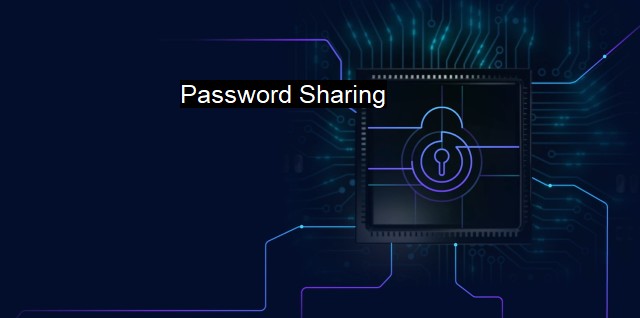What is Password Sharing?
Exploring the Risks of Password Sharing: Understanding the Consequences in Today's Cybersecurity Landscape
Password sharing is a commonly practiced situation in both personal and professional contexts whereby users disclose their account credentials to others, allowing them multiple access to a specific account or profiles. In a digital world, where online platforms and accounts form a substantial part of our daily activities from emails, social media, online banking, to varied subscription services, safeguarding these credentials has become a paramount concern. Predominantly, that's where cybersecurity sets its value, especially against password sharing, which poses severe security threats.Password sharing, although sometimes perceived as a simple act of convenience or trust, can lead to disastrous consequences including identity theft, data breach, financial loss, or damage to personal or professional reputation should those credentials end up in the wrong hands. While the act may seem harmless, especially when sharing with trusted friends, family, or colleagues, it opens doors to potential security risks, and the damage can be exponential.
Password sharing is criticized as it significantly weakens an account's defense system. Regardless of the robust security infrastructure an organization might have in place, password sharing remains to be a latent weak link in the security chain. Every time a password is shared, the control over who has access to the sensitive information diminishes, multiplying the points of vulnerability.
When passwords are shared among personnel in a professional setting, sensitive company information could be exposed, causing unauthorized access or data breaches, a major concern in cybersecurity. Resources such as email inboxes, corporate databases, and digital tools can be misused if the shared credentials fall into wrong intentions. tracking the source of data misuse or leakage becomes exponentially harder when multiple people use the same credentials.
Antivirus, the established first line of defense against most cybersecurity threats, unfortunately, doesn't entirely address the password sharing dilemma. Antivirus programs primarily function to protect against malware intrusion into computer systems. While some advanced antivirus applications provide warning messages regarding unsafe password practices including password sharing, and might offer services such as password managers to aid in maintaining strong, distinct passwords for different accounts; these efforts are merely aiding steps, not complete solutions.
Password sharing can also circumvent two-factor authentication (2FA). 2FA is designed as an extra layer of protection, whereby a users needs to provide two separate pieces of information to gain access. Usually, it involves a combination of a password and a second element like a OTP (One-Time Password) on your mobile device or a fingerprint scan. When a password is shared, it can bypass this added layer of security, again making a cybersecurity loophole.
Unarguably, as the instances of password sharing increase, so does the probability of accounts being compromised. Cybersecurity professionals continuously emphasize the importance of proper password management and regular updates to ensure these defenses provide maximum security. This includes practices such as creating strong, unique passwords for each account, periodically changing these passwords, and never sharing them.
Consequently, creating an environment promoting cyber hygiene and password literacy can massively help curb the password-sharing trend. Organizations should take the initiative to provide password management and cybersecurity training, sufficient enough to illustrate the risks associated with sharing credentials.
Password sharing, a seemingly innocuous act, breaches the common rules of internet security and poses substantial risks in a cybersecurity-outline. Using antivirus applications and password managers can certainly help in facilitating password sanctity, yet, safe practices regarding password use and sharing are unequivocally indispensable as cybersecurity defenses. The major stake of maintaining online security inclines every user to instill a more vigilant, cautious, and sensible approach in dealing with their digital credentials.

Password Sharing FAQs
What is password sharing and why is it a cybersecurity risk?
Password sharing is the practice of giving someone else access to your login credentials for an application or website. It increases the risk of a cyberattack because it creates multiple points of entry for hackers, and it also makes it harder for you to track who has access to your sensitive data.Is it ever safe to share passwords with others?
In general, it is not recommended to share passwords with others, even if it is for legitimate reasons such as sharing access to a work account or a household subscription service. If you must share a password, consider using a password manager that allows password sharing with specific individuals and tracks who has access.How can I prevent password sharing in my organization?
Preventing password sharing in your organization involves educating employees on the risks, implementing strong password policies that require individual account creation and management, and using multi-factor authentication (MFA) to ensure only authorized users have access to sensitive data. You can also use cybersecurity training and regular audits of user accounts to ensure compliance.Does antivirus software help protect against password sharing?
While antivirus software can help protect against some forms of cyberattacks, it cannot prevent password sharing or stop users from sharing passwords. The best way to prevent password sharing and reduce the risk of cyberattacks is to implement strong security practices and policies, including regular cybersecurity training and MFA.| | A | | | B | | | C | | | D | | | E | | | F | | | G | | | H | | | I | | | J | | | K | | | L | | | M | |
| | N | | | O | | | P | | | Q | | | R | | | S | | | T | | | U | | | V | | | W | | | X | | | Y | | | Z | |
| | 1 | | | 2 | | | 3 | | | 4 | | | 7 | | | 8 | | |||||||